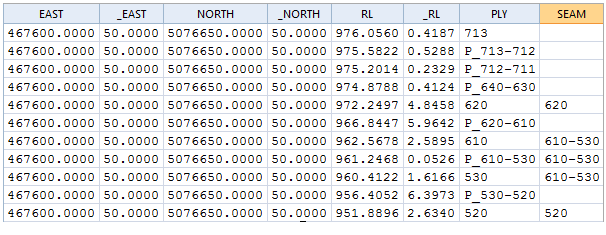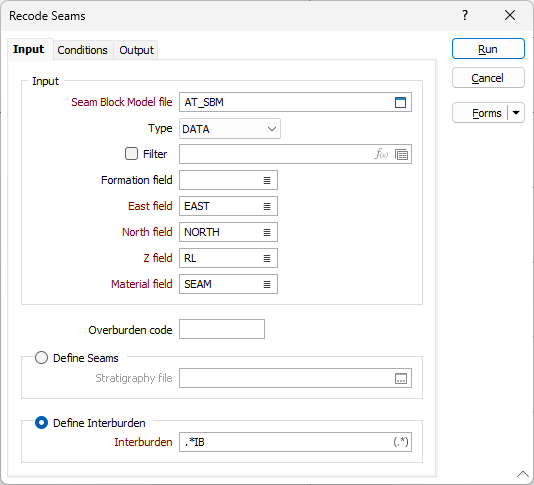Recode Seams
![]()
This function sorts the input Seam Block Model file by East then North then Z (descending) and then inspects each 'column' of blocks (those with the same East and North centres). If an overburden code is defined, any records with that value in the Material field are ignored. The function assumes that all remaining records are either Interburden (Partings) or Coal (Plies). You can either use a Stratigraphy file to define the seam (coal) codes, or you can define Interburden using a Regular Expression match for the Material field.
Once the coal codes are able to be determined, the function scans down the 'column' until it finds a coal block and checks the Interburden thickness between that and the next coal block. If it is less than the Maximum interburden thickness the coal blocks will be treated as though they were a single unit, and coded accordingly. It then repeats this test until it finds a parting greater than the Maximum interburden thickness. All the records that are part of this coal “seam” are coded as per the seam coding “rule”.
There are 2 additional constraints:
- If a Formation field is defined, then seams cannot be combined if they are in different formations (you can use this field in a more generic way. By selecting a field that defines Classification, for example, you can ensure that there is amalgamation of Measured and Indicated coal).
- The unit being combined MUST be contiguous. If the column contains “gaps” these are honoured. Although it is unlikely that the Seam Block Model file will have such gaps, they might be introduced if a filter is applied.
Finally, each coal unit is checked against the minimum seam thickness value.

In the example above:
| Material field = PLY |
| Minimum seam thickness = 0.5 |
| Maximum interburden thickness = 0.5 |
| Seam field = SEAM |
| Seam coding = ABOVE-BELOW |
|
Input
Specify the following inputs in the Recode Seams form:

Seam Block Model file
Double-click (F3) to select an input Seam Block Model file. Seam block models use variable-height blocks, which are not limited to a set sub-blocking interval. Seam splits, plies and partings are easily defined.
This function does not insert or delete any records. Nor does it modify the existing content in any way (unless you have chosen to modify the Input file and the Seam field already exists).
If a filter is applied, the Output file will contain the records that pass the filter. If you have chosen to modify the Input file, then the operation will only affect those records that pass the filter. Those records that do not pass the filter will not be deleted.
Formation field
(Optional) Double-click (F3) to select the name of the field that contains the values that identify each formation. A Formation is a group of seams, modelled independently.
East, North and Z fields
Double-click (F3) to select the name of the East, North and Z coordinate fields in the input Seam Block Model file.
Material field
Unlike the Seam field, which refers specifically to coal, the Material field will contain the values used to code not just the coal seams, but also interburden. If an overburden code is defined, any records with that value in the Material field are ignored.
Overburden code
(Optional) Specify the code value that will be used to identify the overburden layers in the Seam Block Model file. If an Overburden code is specified, any records with that value in the Material field are ignored.
Define Seams
Double-click (F3) to select the name of an input Stratigraphy file. A Stratigraphy file is a compiled file that is used to interpolate and display the stratification of the seams in a Seam file.
Define Interburden
Define
Although regular expressions can be both complex and powerful, a couple of simple suggestions should provide an easy way to define waste codes. The first thing to understand is that the Regular Expression must match the complete code, not just a part of it. There are 3 characters and quantifiers that will allow matching of most waste codes. They are:
| Character | Description | Pattern | Possible Matches |
|---|---|---|---|
| . | Matches any single character | .B | IB or OB |
| * | Matches previous element zero or more times | .*IB | AT01_IB or FC22_IB |
| | | Matches any element separated by pipe (|) | OB|.*IB | OB or AT01_IB or FC22_IB |
Some examples:
| Waste Codes | Patterns that match |
|---|---|
| OB, AE_IB, FJ_IB, KL_IB | OB|AE_IB|FJ_IB|KL_IB |
| OB|.*_IB | |
| .*B | |
| OB, PT_AE, PT_FJ, PT_KL | OB|PT.* |
Regular Expressions are used elsewhere in the application.
Forms
Click the Forms button to select and open a saved form set, or if a form set has been loaded, save the current form set.
Run
Finally, click the Run button to begin the process.